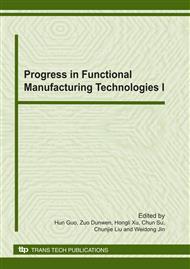p.337
p.344
p.349
p.355
p.362
p.368
p.374
p.380
p.386
The Effect of the Scanning Mode on the Finished Precision for SLA Technology
Abstract:
Stereo lithography apparatus is an advanced technology that uses photopolymers as the raw materials from which the prototypes are built. The RP manufacture system uses lasers or ultraviolet light to expose selectively the surface of the liquid resin and builds a three-dimensional part according its CAD model in a layer-by-layer manner. The absorption of energy causes photo-polymerization that changes the liquid resin into a solid, expanding the cured volume but shrinking simultaneously. The primary reason for the volume distortion and deformation of the stereo lithography apparatus part are the interlaminar stress generated by resin contraction. The volume shrinkage and curl distortion of the resin will lead to poor accuracy of the built prototype because the bending stress cannot be compensated for. Selecting a non-standard gear as experimental object and manufactured in the SCPS350B rapid prototyping machine. Four kinds of scanning mode, includes X-X mode, X-Y mode, XY mode and XY ST mode, are respectively carried out. From the results, it is found that SLA parameters, i.e. scanning mode and scanning speed significantly affect the forming precision of the prototype. The accuracy of the prototype with XYST mode is prior to the XY mode, and the X-Y mode is prior to the X-X mode. With the lower scanning speed and surface recoating process can further improve the finished precision.
Info:
Periodical:
Pages:
374-379
Citation:
Online since:
December 2010
Authors:
Price:
Сopyright:
© 2011 Trans Tech Publications Ltd. All Rights Reserved
Share:
Citation:


